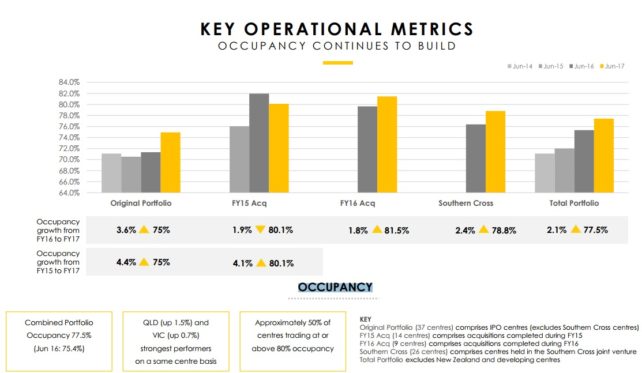The National Storage REIT (ASX: NSR) share price fell 1% to $1.56 this morning, after the company released its annual results. Here's what you need to know:
- Revenue grew 47% to $118 million
- Underlying net profit after tax (NPAT) rose 57% to $45.7 million
- Underlying earnings per share up 6% to 9.2 cents per share
- Dividends of 9.2 cents per share (98% of operating cash flow)
- Gearing (debt) reduced slightly from 38% to 37%
- Moderate increase in rates per square metre across the portfolio
- Net tangible assets of $1.34 per stapled security ('per share')
- Forecasting between 9.6 cents and 10.1 cents per share in earnings in FY18
- Forecast dividends of 9.6 cents to 10 cents per share in FY18
So what?
A strong year for National Storage, which saw progress on the important metrics including higher fees per square metre, lower debt, higher occupancy, and wider profit margins. Pleasingly, despite significant vacant space at its centres, management has been able to grow revenues by increasing fees. This could suggest either that there is a lack of competition in the storage space, and/or that it's painful for customers to move. Either way, a degree of pricing power could be a good thing.

Plus, National Storage has plenty of space to both accept increased demand without having to build new facilities, and the ability to expand its facilities in certain key areas. 2018 will see feasibility reports on potential expansion, as well as the potential installation of solar power facilities across the portfolio. Solar power installations across 50 centres are expected to cost $4 million and save up to $600,000 a year in electricity from 2019, an attractive investment.
Now what?
National Storage is unlikely to shoot the lights out from here, in my opinion. It's very difficult to conceive of a future where NSR is worth $4.50 a share in the next 5 years, for example, without huge and risky acquisitions. Still, the company appears well run and has significant ability to generate greater value from within its existing portfolio, through a combination of higher rates, higher occupancy, and lower costs. As a result I think this is an attractive business for dividend-focused shareholders, and it is not too highly priced, unlike several other REITs I can think of.








